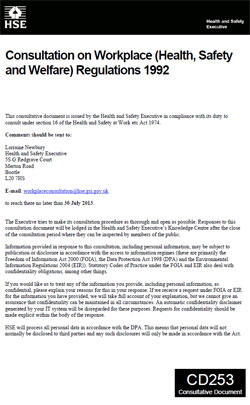With the closing of the public consultation on the Workplace Regulations approved code of practice on 30th July, trade unionists, workers and those concerned about health safety and welfare at work, still have the opportunity to address the issues of high temperatures at work.
You wont see anything in the HSE’s revision of the ACop, so don’t wait for them to amend their own ACoP on temperatures at work. They simply don’t see it as an issue!
 As we are struggling with the heat, millions of workers are facing problems because of a lack of action by their employer to do something about it. In fact it is one of the biggest issues that health and safety representatives have to deal with at this time of the year.
As we are struggling with the heat, millions of workers are facing problems because of a lack of action by their employer to do something about it. In fact it is one of the biggest issues that health and safety representatives have to deal with at this time of the year.
Because there is no maximum temperature for workplaces many workers are forced to work in temperatures which are not only uncomfortable, but which could damage their health.
The lack of a legal maximum is a major omission. The Approved Code of Practice (ACoP) to the Workplace regulations does give a minimum temperature along with guidance on how it can be achieved, yet no maximum. As a result, health and safety representatives often find that employers refuse to accept arguments that they have to take action on high temperatures, but are far more likely to take action when it gets to cold. This is simply because there is a set figure in the Approved Code of Practice.
The HSE had a perfect opportunity to do something about it. They are currently consulting on a revised ACoP for the Workplace Regulations yet have totally ignored the issue. So we will still have a minimum temperature but no maximum. This is despite over a decade of campaigning and research showing the scale of the problem.
When the workplace gets too hot it is more than just an issue about comfort. If the temperature goes too high then it can become a health and safety issue. If people get too hot, they risk dizziness, fainting, or even heat cramps. In very hot conditions the body’s blood temperature rises. If the blood temperature rises above 39 °C, there is a risk of heat stroke or collapse. Delirium or confusion can occur above 41°C. Blood temperatures at this level can prove fatal and even if a worker does recover, they may suffer irreparable organ damage.
 However even at lower temperatures heat leads to a loss of concentration and increased tiredness, which means that workers are more likely to put themselves or others at risk.High temperatures mean there is an increase in the likelihood of accidents due to reduced concentration; slippery, sweaty palms as well as an increase of discomfort of some personal protective gear which can result in reduced protection through inappropriate usage or non-usage.
However even at lower temperatures heat leads to a loss of concentration and increased tiredness, which means that workers are more likely to put themselves or others at risk.High temperatures mean there is an increase in the likelihood of accidents due to reduced concentration; slippery, sweaty palms as well as an increase of discomfort of some personal protective gear which can result in reduced protection through inappropriate usage or non-usage.
Heat can also aggravate other medical conditions and illnesses such as high blood pressure or heart disease due to increased load on the heart as well as interacting with, or increasing the effect of other workplace hazards. Workers at greater risk of heat stress include those who are 65 years of age or older, are overweight, have heart disease or high blood pressure, or take medications that may be affected by extreme heat. In addition high temperatures are associated with a reduced sperm count and can be dangerous during pregnancy.
So clearly it is a health and safety issue, and one that is a major problem in many workplaces. In the 2012 (which had a particularly cold summer) TUC safety representatives survey, 14% of safety representatives cited high temperatures as one of their top concerns.
In some sectors it was particularly high including central and local government, education and manufacturing. Often the biggest problem was in post-war buildings with a high glass content.
A recent survey of almost 6,000 teachers, school and college leaders and Health and Safety Representatives, found that 94% of respondents reported that they had worked in excessively high temperatures during the summer, with 42% doing so regularly.
Given the fact that average temperatures are likely to increase over coming years as a result of global warming this is a problem that is likely to increase. It is also a problem that is usually relatively easy to resolve. Often simple steps, such as having windows that can be opened, fans, moving staff away from windows or sources of heat or installing ventilation or air-cooling will be effective. If there were a maximum temperature it would also help ensure that the issue of temperature was taken into account during the design stage for new buildings or during refurbishment.
The consultation on the Workplace regulations gives us the perfect opportunity to try to get a change to the regulations. The consultation runs until the 30th of July so get a response in explaining why a maximum temperature is needed in your workplace.
This consultation began on 7 May 2013 and ends on 30 July 2013.
Responses should be sent by 30 July 2013 to:
Lorraine Newbury
Health and Safety Executive
5.S.G Redgrave Court
Merton Road
Bootle
Liverpool
L20 7HS
Email: workplaceconsultation@hse.gsi.gov.uk
Respond to the consultation using the online questionnaire or download a form  to complete.
to complete.
The consultative document and a draft version of the revised ACOP is available from the Unionsafaety E-Library Database, and can be downloaded using the search category of ‘HSE Consultations’
Source: TUC / Unionsafety


 As we are struggling with the heat, millions of workers are facing problems because of a lack of action by their employer to do something about it. In fact it is one of the biggest issues that health and safety representatives have to deal with at this time of the year.
As we are struggling with the heat, millions of workers are facing problems because of a lack of action by their employer to do something about it. In fact it is one of the biggest issues that health and safety representatives have to deal with at this time of the year. However even at lower temperatures heat leads to a loss of concentration and increased tiredness, which means that workers are more likely to put themselves or others at risk.High temperatures mean there is an increase in the likelihood of accidents due to reduced concentration; slippery, sweaty palms as well as an increase of discomfort of some personal protective gear which can result in reduced protection through inappropriate usage or non-usage.
However even at lower temperatures heat leads to a loss of concentration and increased tiredness, which means that workers are more likely to put themselves or others at risk.High temperatures mean there is an increase in the likelihood of accidents due to reduced concentration; slippery, sweaty palms as well as an increase of discomfort of some personal protective gear which can result in reduced protection through inappropriate usage or non-usage.